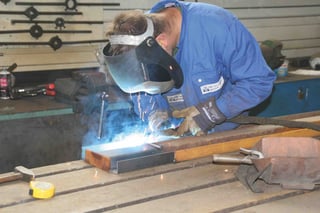Usually when I'm meeting with a Foreman or Production Manager and get a chance to talk first hand to his or her welders, one of the most common topics that come up is their contact tips. The problem: they have to change them too much. This kills productivity for the shop, takes a big bite out of cost, and generally just creates a less efficient atmosphere for the welder to work in.
So why are your contact tips not lasting? And what are the problems that cause the contact tips to fail? How do you prevent them? The three most common issues you probably encounter all the time are:
- Poor Contact Tip Life & Quality
- Burnback
- Wire Whip
I'm going to go through below the 3 most common contact tip problems I run across on a day to day basis, and how typically you can overcome those problems.
Poor Contact Tip Life & Quality
They look the same, thread the same, feel the same in your hand, but once you put it to the test it's a different story. Almost every welding supply manufacturer makes a copper contact tip, but if you've tried many of them it's easy to tell that not all hold up the same.
Not all tips are created equal. Poor contact tips equal bad quality welds and high amounts of downtime. The goal of any contact tip is to supply voltage into the wire. But if you have a contact tip that isn't conducting voltage the way it should you'll experience high resistance, increased heat at the tip, increased wear, and weld quality issues. How? A contact tip that is not conducting voltage as it should will produce more spatter and micro-arcing.
The best solution for this problem is to look at and consider higher grade contact tips. Using a copper zirconium, silver-plated, or even a purer copper tip can make a big difference in contact top performance, life span, and weld quality. We actually detail different contact tip materials in another blog post.
 Looking closely at your contact tip tolerance is another way to help protect and get more life out of your contact tip. Not all contact tip makers manufacture tips with the same tolerances on the tip orifice. Those that have larger tolerances, or deviations, on the contact tip size can lead to issues like micro-arcing and poor conductivity. Take a look at your contact tip tolerances and see how snug the wire is on the stick out.
Looking closely at your contact tip tolerance is another way to help protect and get more life out of your contact tip. Not all contact tip makers manufacture tips with the same tolerances on the tip orifice. Those that have larger tolerances, or deviations, on the contact tip size can lead to issues like micro-arcing and poor conductivity. Take a look at your contact tip tolerances and see how snug the wire is on the stick out.
Burnback
Burnback is when the wire in going through the orifice of the tip arcs right at the beginning of the tip and burns back into the contact tip. Burnback is a problem for welders and welding operations - especially in professional environments, because it creates a lot of downtime. Whether you try to file the burnback damage off the tip and pull the wire, or just have to junk it and replace it, either way it costs the welder time away from fabricating. And if you take the most common (and easy) route, replacing the contact tip, you're adding material cost as well as time, which compounds the loss.
To solve getting burnback it really comes down to understanding the reasons you get burnback in the first place. There are a lot of causes, but some of the major ones are:
- Weld Parameters
- Too Low or High Voltage
- Dirty Material on the Base Metal
- Poor Quality Filler Metal
- Poor/Incorrect Contact Tip
- Worn or Damaged Liner
One of the more common causes is an incorrect tip and wire size. If you're using, for example, an .045 contact tip welding with .035 wire, this will cause burnback. An incorrect tip size translates to poor conductivity inside the contact tip, micro-arcing inside the contact tip, and the wire dragging and experiencing burnback as a result. So check to make sure you're using a contact tip size that matches the wire first if you get burnback.
Poor quality filler metal or tip material is another reason for burnback that's pretty common. Using higher grade materials will help to make the arc start and conductivity cleaner and more reliable, and cut down on the micro-arcing and other early signs of burnback.
Looking at the base metal is another solution. If it's dirty or you're trying to weld through some rust or oxidation, burnback might occur. Clean and prep your base metal thoroughly before you weld whenever possible. Also make sure to check your liner for contaminates.
Wire Whip
This is typically more of a problem in automation than handheld welding. Wire whip is when the wire sticking out from the contact tip kind of wanders around a little away from the direction of the contact tip orifice. It's an issue of the contact tip, however, because inside the tip it's not holding the wire snug and is allowing it to tilt off center and not hit the welding joint where it needs to.
Wire whip is caused a lot by simple cable torsion or welding operators not having or wire straightener. When wire is coming out from a spool barrel it has a memory, or cast, so when the wire is unspooled from the barrel through the liner and eventually out of the contact tip, that memory is going to play a factor in where the wire goes. In some cases, it can miss the whole joint.
When a welder experiences wire whip, they often can adjust position and manipulate the torch neck to overcome that problem. In automation, it's a problem that can't always be eliminated but can always at least be compensated for. One of the ways to overcome wire whip tolerance in this case speaks to the tip orifice. is by using tight tolerance contact tips, which seat the wire in a much more constrictive manner and allow a minimal amount of deviation from the direction of the contact tip orifice.
Any problems you run into constantly with your consumables? Share your experiences (and solutions) in the comment box, and if you'd like to see what a different type of contact tip - whether higher grade or tighter tolerance - can do for your productivity, contact is and reach out to a Binzel Sales Manager in your area.

